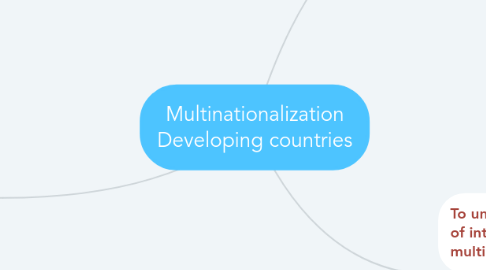
1. New ideas on the multinationalization process
1.1. Challenges of multinationalization.
1.1.1. The knowledge needed to export and become an international company differs from the knowledge needed to establish FDI and become a multinational.
1.1.2. The company needs to be able to transfer productive resources to the country
1.1.3. The company must ensure that it can transfer the advantage associated with the resources to the new country.
1.1.4. The company must avoid transferring a disadvantage to the new country
1.1.5. The company not only lacks knowledge but also the necessary assets to operate on a larger scale, to compete in the industry or to operate in the new institutional sector environment, creating liabilities of expansion, novelty and strangeness, respectively.
1.2. Multinationalization driver
1.2.1. the transformation of the locational advantage as countries moved from import substitution to
1.2.2. the reform induced companies to develop their ownership advantages in order to operate in a more competitive environment.
1.2.3. The development of property advantages, in turn, helped companies overcome the additional difficulties of internalizing
1.2.4. Countries transferred resources and allowed them to become multinational corporations. Therefore, we are likely to observe that multilatinas are exporters but not MNCs under import substitution regimes, but they begin to become MNCs when it comes to structural processes.
1.2.5. Reforms are carried out that reduce regulations and liberalize the entry of foreign companies into the country.
1.3. Location to start the multinationalization.
1.3.1. Enterprises in developing countries can follow four alternative strategies to begin their multinationalization: (1) start in countries that are close to culture and development, (2) start in countries that are distant in culture and development, (3) start in countries that are culturally close but distant in development, and (4) start in countries that are culturally distant but close in development.
1.3.1.1. we will see that multilatinas are more likely to begin to multinationalise in countries that have a distant culture. We will see that multilatinas are more likely to begin to be multinationalised in countries that have a distant culture and are developing when their resources and knowledge are linked to the level of development of the country but are not culturally specific.
2. Multi-latinas companies
2.1. It is a company whose base is in some Latin American country and which also has operations in other countries also in Latin America, ie are managed regionally to find similarities such as language and certain cultural characteristics, but risks opening unknown markets.
3. To understand the process of internationalization of multilatinas
3.1. Two aspects
3.1.1. Analyze when companies established FDI and became multinational companies
3.1.1.1. *For this purpose it was first necessary to codify the year of their first FDI and compare it with the year when they were created. *With this it was found that there is a relatively large gap between the time when companies were created and the time when companies established FDI. *The timing of the company's first FDI does not appear to be a coincidence, but a reaction to changes in the country's Conditions of Operation
3.1.2. Study the place where companies were the first to establish FDI.
3.1.2.1. *This helps to further refine our understanding of the multinationalization process and how it works. *The interaction between advantages and difficulties affects the beginning of the process. *The cultural distance or proximity between the country of origin and the host country of the first FDI is assessed as a proxy for psychic distance.
3.1.2.2. The country of origin does not seem to influence this, but the characteristics of the industry seem to influence this decision. These characteristics appear to be linked to the difficulties of using products in different cultures and the desire to benefit from the advantages of operating in other countries.

